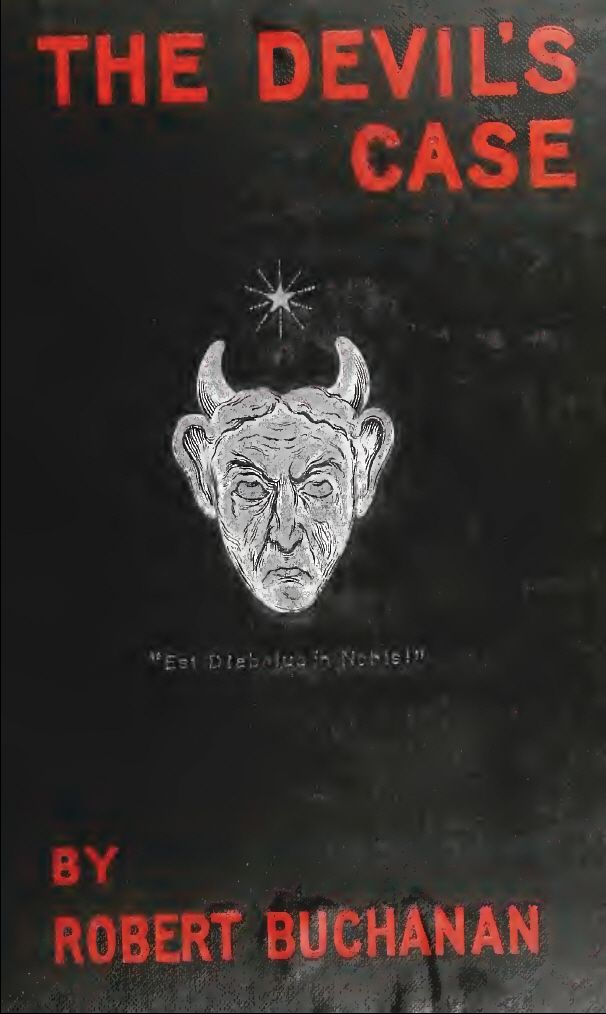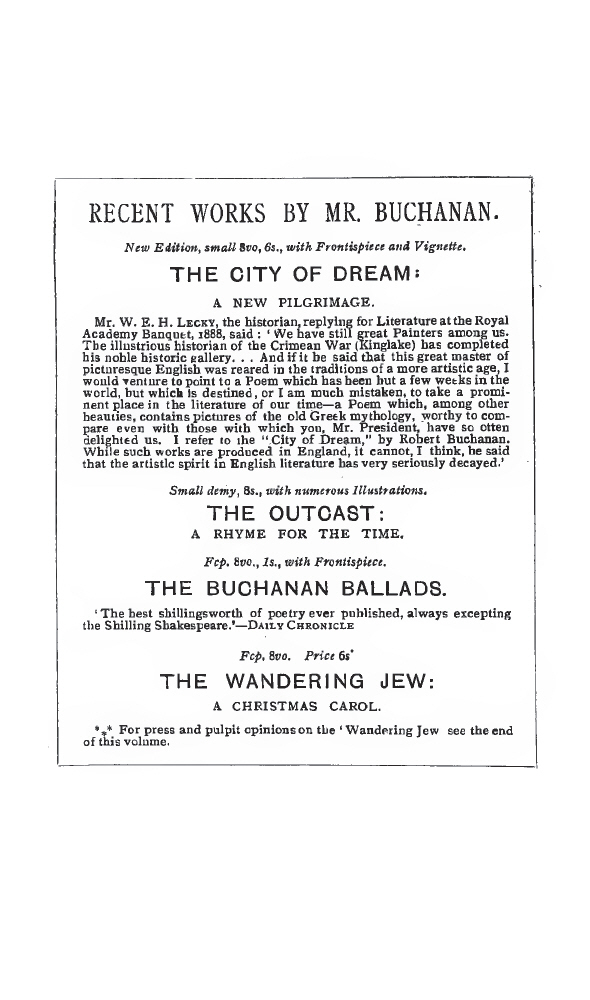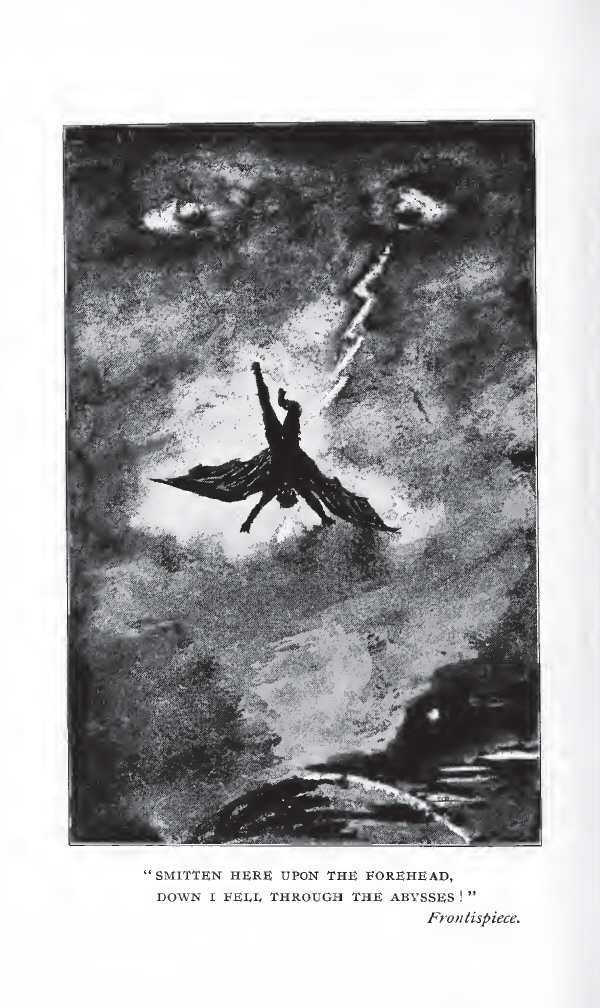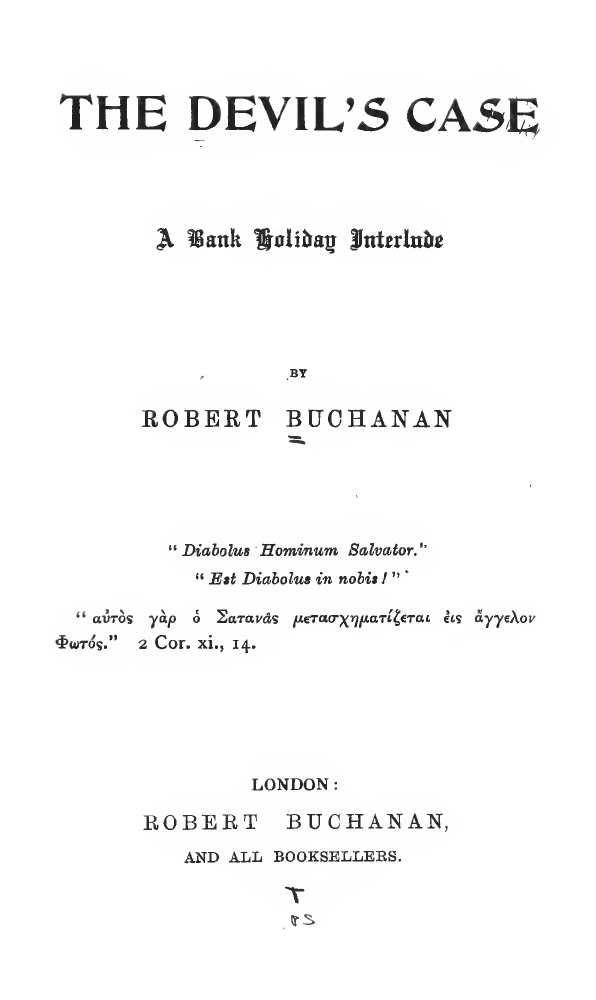ROBERT WILLIAMS BUCHANAN (1841 - 1901)
|
ROBERT WILLIAMS BUCHANAN (1841 - 1901) |
|
|
|
|
|
|
|
|
THE DEVIL’S CASE |
 |
|
_____ THE DEVIL’S CASE. |
 |
|||||
 |
|||||
 |
|||||
|
THE DEVIL’S CASE
A Bank Holiday Interlude
BY ROBERT BUCHANAN
“Diabolus Hominum Salvator.” “Est Diabolus in nobis!” |
 |
|
LONDON: ROBERT BUCHANAN, AND ALL BOOKSELLERS. _____
PRINTED BY THE NEW TEMPLE PRESS 17, GRANT ROAD ADDISCOMBE, CROYDON. _____
PAGE DEDICATION . . . . . . . . . vii THE DEVIL’S CASE . . . . . . . . 1 EPILOGUE: THE LITANY DE PROFUNDIS . . 159 _____
[Notes: “Diabolus Hominum Salvator” is a reworking of the Christogram, IHS, “Iesus Hominum Salvator ” - “Jesus saviour of men”. So, “The Devil saviour of men.” The illustrators of The Devil’s Case are not credited and I have only come across one review of the book which mentions the illustrations - Reynolds’s Newspaper ended its review with the following sentence: “A serious [sic] of striking illustrations add to the interest of the book.” One of the things which strikes me about the illustrations is that they do appear rather amateurish - certainly when compared with the pictures in Buchanan’s earlier illustrated works. And the fact that none are signed by the artist leads me to wonder whether they are by Buchanan himself. At least the portrait of the devil on the front cover and the frontispiece above, and the illustrations opposite pages 64, 72, 78 and 90 - the style of the one opposite page 131 seems to be different. I have no hard evidence for this but I did come across the following in The Glasgow Herald of 6th February, 1897: |
 |
|
Of course, neither The Ballad of Mary the Mother or The New Rome are illustrated, and by the time the latter was published (in December 1898) Buchanan had given up his own publishing venture. Still, it does seem to indicate that Buchanan was trying his hand at illustration, which would explain the amateurish nature of the pictures in The Devil’s Case. As for the different style of the picture opposite page 131, there is that article about Harriett Jay in the Omaha Daily Bee which includes the following sentence: “While waiting for a possible debut on the New York stage she is writing the concluding chapters of a novel that is running in a London paper and drawing the illustrations for it.” But, maybe that’s taking speculation too far. The Devil’s Case was published in February 1896, along with the pamphlet, Is Barabbas a necessity? A discourse on publishers and publishing, the first fruits of Buchanan’s self-publishing venture. A letter to Dr. Stodart-Walker, quoted in Chapter 28 of Jay’s biography, indicates that the poem was actually completed a year before its eventual publication: Feb. 22, 1895. “DEAR WALKER,—I am so sorry you have been ill, and as glad to hear you are all right again. It is see-saw with us all, and I am now myself a little seedy and over-worked. I am hoping to get out of town very soon, for indeed I require a rest. DEDICATION. November, 1894. While the life blood was spun How swift the hours run Of all the joys won Yet lo! all is done! All is o’er, ere begun! . . . “The book itself ends with a new verse edition of the Litany which will sadden the scribes and pharisees of modern Christianity. Thanks for the lecture, and for the kind allusion to your friend. It touched me greatly, for I saw in it a fresh proof of your affection. The dedication to his mother differs slightly from the published version which opens the poem. Buchanan’s mother had died on 5th November, 1894, towards the end of a year which had also seen the death of his friend, Roden Noel (also mentioned in the poem) on 26th May and the bankruptcy proceedings which had stretched from June to August and had been extensively reported in the newspapers. The opening of The Devil’s Case captures Buchanan’s mood at the end of this annus horribilis (thank you Ma’am). I have no explanation for the delay in the book’s publication, but Buchanan’s finances did not improve until the success of The Strange Adventures of Miss Brown in June 1895, which would have provided the money to set up as his own publisher. ]
Back to Poetry
|
|
|
|
|
|
|